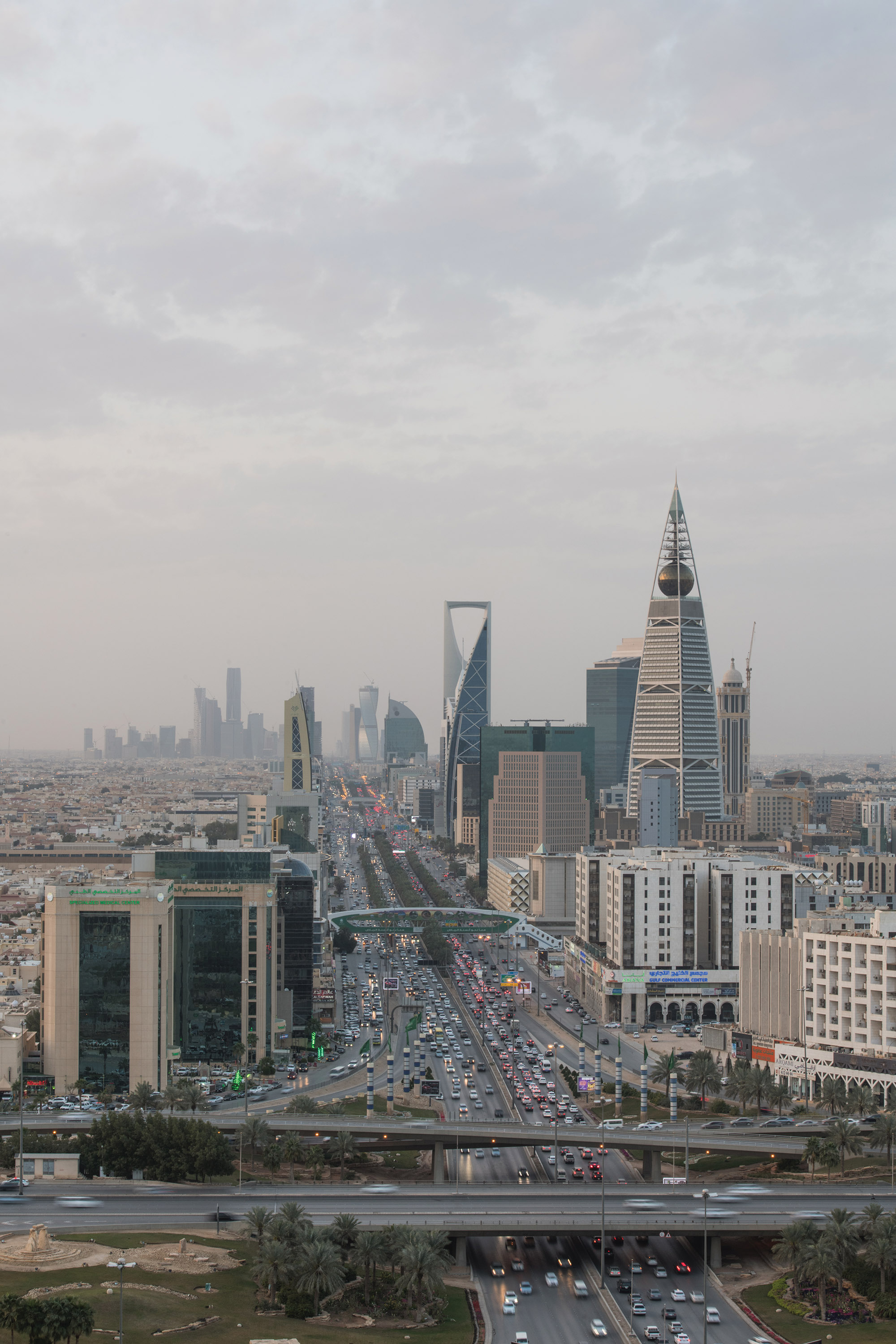Outlook for 2021
Governments and central banks around the globe are expected to continue providing more fiscal and monetary stimuli to reduce uncertainty, improve liquidity, and harness growth. In particular, major central banks will keep extraordinary policy support in place until economic recoveries are well established. The support includes actions such as asset purchases, credit facilities, liquidity programs, and regulatory forbearance. Policy rates of the US Federal Reserve, European Central Bank, Bank of Japan, and Bank of England are expected to remain near zero in 2021, thus providing liquidity and a boost to recovery.

Vision 2030 will continue to provide a broad framework to help transform Saudi Arabia during 2021 and in the following years.
Advanced and Emerging Economies
Economic growth of both advanced economies and emerging economies is projected to recover in 2021, as the world is likely to develop a COVID-19 vaccine. The wide-ranging deterioration seen in all major economic sectors including fixed investment, consumption, trade and industrial production in 2020 is expected to reverse in 2021 – back to 2019 levels – with all these sectors making positive contributions to economic growth in 2021.
Regional Economies
Like other oil and commodity exporters, Saudi Arabia will not have the benefit of a sharp recovery in oil prices as in the past and will need to address internal and external imbalances from reduced income through fiscal adjustment and reforms. In this context, the Vision 2030 program will continue to provide a broad framework to help transform Saudi Arabia during 2021 and in the following years. In terms of economic diversification, Vision 2030 relies on diverse initiatives to develop a thriving private sector and promote greater investment opportunities, while fostering greater activity in underdeveloped sectors of the economy such as mining, defense industries, retail services, and renewable energy. As a result, after experiencing a deep contraction in 2020, Saudi real GDP growth will improve moderately in 2021.
In the US, a successful coronavirus inoculation campaign is likely to allow the economy to transition from a recession in 2020 to an expansion in 2021. The ongoing sharp decline in the unemployment rate is expected to continue in 2021, providing a boost to consumer spending and fixed investment. The overall improvement in the global economy is likely to spur international trade. The Fed will continue resurrecting several credit facilities from 2008-2009 and creating new ones to support the economy and ensure normal functioning of financial markets. It is expected that these credit facilities will be utilized, and will prove effective in narrowing credit spreads, and that the Fed will expand its holding of term Treasuries by nearly $2 trillion. In addition, based on recent Fed communication, it is expected the Fed will tolerate inflation modestly above 2% in order to establish its 2% objective as an average rather than a ceiling.
China’s economic growth is expected to recover in 2021, with the likely commercialization of a vaccine for COVID 19. The government’s fiscal and monetary policies will remain accommodative to spur consumer and investor sentiment and support growth. As a result, consumer spending and fixed investment will improve considerably. Under Jo Biden’s presidency in the US, it is likely that there will be a return to a multilateral approach to trade policy, which will help China in expanding its international trade. As soon as the Chinese economy returns to normalcy, the country will re-embark on its transformation from an export and investment-led model to a private consumption-led model.
The weakness of the Eurozone economy is likely to reverse in 2021, with the Eurozone and all major economies of the Eurozone recording an economic recovery. Private consumption, fixed investment and exports will recover. Among the larger member states, economic recovery will be the most pronounced in France, Spain, and Italy, partly reflecting their comparatively severe declines in 2020. Fiscal policy support will be extended into 2021. Disbursements from the European Union’s Recovery and Resilience Facility will continue in 2021. Given post-GFC lessons, underlying fiscal tightening is not expected until 2022. The European Central Bank will continue providing policy stimulus. The Pandemic Emergency Purchase Program will remain the preferred policy instrument, and there will also be a EUR500-billion uplift in asset purchases.

The ongoing sharp decline in the unemployment in the US is expected to continue in 2021, providing a boost to consumer spending and fixed investment.
GLOBAL INDUSTRIAL PRODUCTION
The world’s global industrial production growth is expected to recover in 2021 after recording a recession in 2020. The improvement will likely be somewhat broad based, with industrial production growth increasing in most advanced economies and emerging economies in 2021. Among major economies, the US, the Eurozone, Japan, China and India will likely see a significant improvement in industrial production growth.xperience a decline in industrial production growth.

China's economic growth is anticipated to recover in 2021.
Industry Segment Trends
The world’s industrial production growth is expected to witness lower growth in 2020, with the US, EU and Asia economies experiencing slower growth in addition to the disruptions to industries supply chains caused by coronavirus. The petrochemicals dependent industry sectors are expected to witness diverse trends. The automotive industry is expected to remain in contraction mode during 2020 as a result of slowdown in the US, China and Europe. Unlike the automotive industry, the construction industry is expected to improve in 2020 driven by growth in Asia Pacific. The textile and electronic industries are expected also to grow in 2020 as demand for these two sectors less affected by global economic slowdown. Healthcare sectors are expected to benefit from governments’ efforts to fight coronavirus.
PETROCHEMICALS MARKETS
The World Health Organization is not expecting a full end to the pandemic before 2024, based on the global capacity to produce vaccines and distribute two billion doses/year. As a result, the petrochemicals industry is expected to continue to be challenged in 2021. In addition to the pandemic, the industry is facing other major challenges such as over-capacities, trade tensions and environmental sustainability.
Excess supply is expected for most products, many new Chinese plants start during 2021. A shrinking global economy and weak automotive and durable goods sectors is expected to suppress demand in 2021 for some products. Localized lockdowns around the globe in response to the second and third waves will add to the pressure on demand and limit prices improvement. The ethylene chain (SABIC’s major business) is expected to be the most challenged chain. Supply growth will surpass demand growth in 2021 because of additions across the chain supported by low US natural gas prices. As a result, petrochemicals prices are expected to remain under pressure during 2021.
Low global demand for methanol and additional supplies from US will continue to weigh in on prices. Plenty of US PE exports, plus new Chinese capacities, are expected to maintain pressure on prices. The US is also expected to maintain its new ehylene glycol exports to the world, while China drives for higher self-sufficiency in ethylene glycols. These two factors along with an already weaker global demand, will add more pressure on prices. Demand from most of the derivatives is expected to be weak in all regions, and will be heavily impacted by production cutbacks among Chinese PET producers due to weak market, high inventory and poor operating economics.
FEEDSTOCK MARKET
Oil prices are under pressure while supply remains abundant and demand remains weak mainly because of slow recovery in travel and transportation. Global naphtha price is expected to slightly increase with slightly better demand. US natural gas and ethane prices are expected to slightly increase as a result of better demand and tighter supply.

The world's global industrial production growth is likely to recover in 2021 after recording a recession in 2020.
